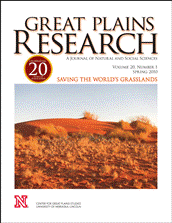Center for Great Plains Studies

Great Plains Research: A Journal of Natural and Social Sciences (through 2013)
Date of this Version
Spring 2000
Document Type
Article
Abstract
The pre-settlement Platte River is commonly described as a mostly unwooded prairie river, comprised of water, sand, and wet grassland. However, primary historical accounts do not support this prairie river concept. Instead, the early accounts and quantitative information from the General Land Office survey indicate that, prior to settlement by European immigrants, the Platte was a wooded river traversing a prairie landscape. Woodland was reported as dense on innumerable islands in the channel, but scattered along on the outer banks. This woodland was cleared during exploration and early settlement. Thus, the openness of the post-settlement river observed early in the 1900s was an artifact of deforestation rather than of the result of natural processes. Since the 1930s, however, reforestation and channel narrowing have occurred in response to reduced stream flow and less demand for timber. The new woodland harbors high biodiversity, while occupying some areas formerly available to certain aquatic avifauna. This historical synthesis should help to reformulate restoration targets for the Platte River ecosystem.


Comments
Published in Great Plains Research 10 (Spring 2000): 39-68. Copyright © 2000 The Center for Great Plains Studies, University of Nebraska–Lincoln. Used by permission. http://www.unl.edu/plains/publications/GPR/gpr.shtml